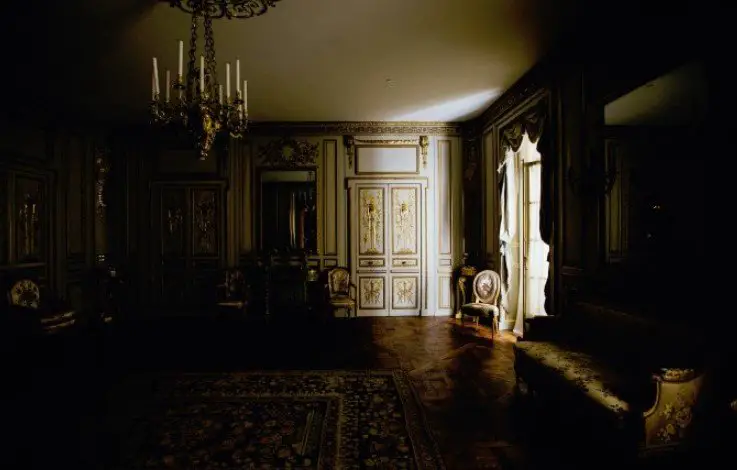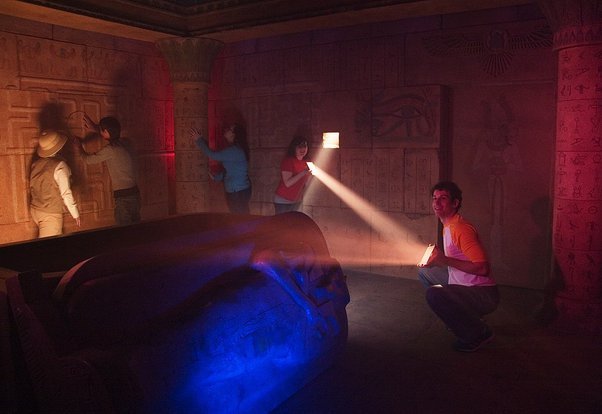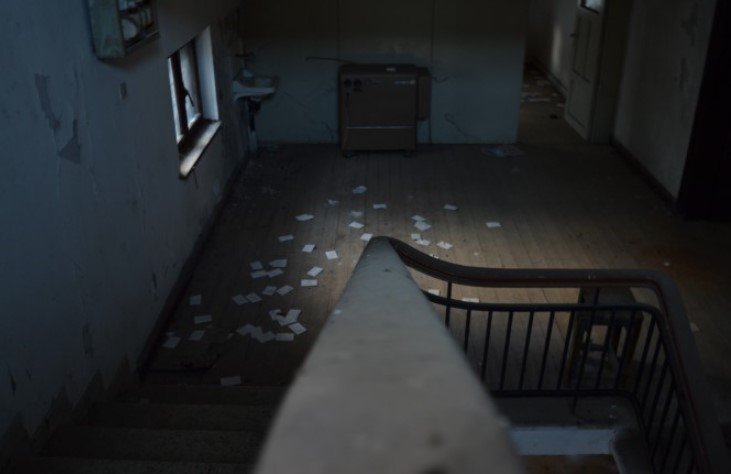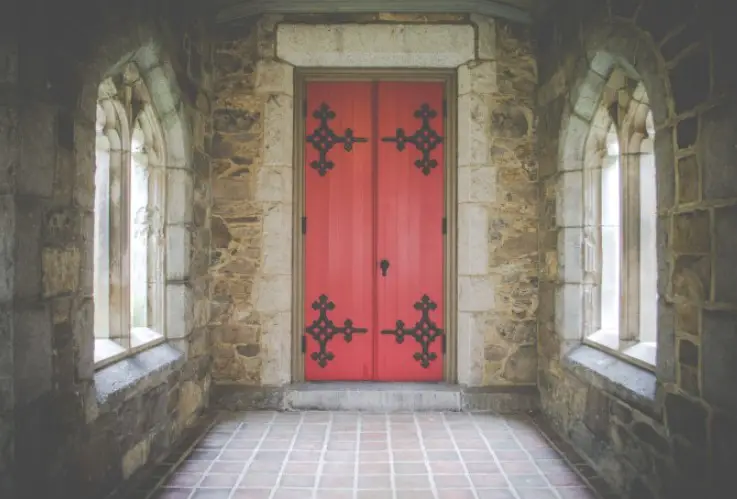Last Updated on July 11, 2023 By Emma W. Thomas
The number of puzzles in an escape room varies depending on the members present in the room. A typical room will have 10 to 30 puzzles. But, this may vary depending on the arrangement and design of the room and how knowledgeable you can solve various puzzles to find your way out.
Escape room design ideas

There are ways to develop an escape room, but the participants are not given puzzles to solve in the first instance. The information below will help you develop many ideas for designing the escape room.
Using equations
While this method is mathematical, it doesn’t mean you have to be good at Math. You come up with an escape room puzzle using an equation with a missing value that gives the solution. The equation must not be necessarily written down or on the walls. You can decide to arrange the room to display an equation with a bit of figuring out.
The lighting of the room
The lighting of room puzzles is mostly used in rooms with large spaces and pathways. This method allows you to have a specific arrangement of light bulbs that follow a certain sequence. For example, you can have your bulbs installed in the form of an arrow pointing to the exit. Make it more complicated by having the arrow pointing in the direction of a secret key to open the door.
Arrangement of your room
While it may not necessarily be the best way, you can have some of your furniture cover the secret door. A cabinet, in this case, can do well, or a wardrobe if you want to have it in a bedroom. Alternatively, a bookshelf is among the most common form of creating a solution to an escape room. Arranging books in a specific way or having them cover a secret section of the room also works well. You can also make a hole in the book and place the secret key inside, but put that book on a crowded surface or inside the shelf.
Using texts and numbers
Numbers can be a better way to conceal something important, like an escape route. Besides using numbers in an equation, you can mix them with letters to create a mismatch that requires solving skills. Inverting some numbers and making others slanted is a great way to make a nice escape room because such tactics are rarely noticed.
Hidden objects
Hiding an object can be easily unraveled, but maneuvering some objects to create an escape room makes it hard to discover the answer. For example, hiding an object behind a picture on a wall may seem obvious. However, having a section of a picture painted with the way out is a good way to go with this method.
Search for objects from odd places
The simple trick is keeping items just beyond what eyes can see. However, the places should not be so common. These could include sections of the room that are less likely to be suspected, like in a book or a jacket pocket. Once in a while, players may have search tools to detect the way out easily. Such tools are often used in very suspicious places, like behind the furniture available in the escape room. Another place to use can be on top of a ledge, behind common room sections, and inside containers.
Create a message with invisible ink
Invisible ink refers to writing on glass. Let the secret code or the clue be embedded on a glass surface that only becomes visible when the glass is modified. Remember to give a clue on what is to be done on the glass to reveal the escape. In this case, give a clue that directs participants to blow over the glass surface for the solution to become visible as air condenses to reveal what participants should do.
Use lock combinations
A lock combination system with different lengths is one way to make a quick combination that team players can’t elucidate. The most common are the directional locks, 4-digit lock combinations, and 5-letter word locks. They create a challenge to ensure that the members have figured out to get the right code combination before unraveling the sequence.
A good lock combination should have at least 5-digits since someone can easily guess the last digit or letter if they know the first three values. It’s also good to use a lock combination of words that are not so common.
Using objects to trigger sensors
This is the best way to create a puzzle compared to other contemporary techniques. However, a small electronics project is to be involved. Place an electronic device strategically to trigger some sensations that will unravel the puzzle. It could range from a simple way of turning an item or a certain object in the escape room to shine some light to more sophisticated technology involving passwords that activate sensors.
How Many Puzzles Are in the Typical Escape Room?

The number of puzzles in a typical escape room can vary depending on the design and complexity of the room. Generally, you can expect to encounter multiple puzzles throughout the game. The exact number can range from around 10 to 30 puzzles or even more, depending on the size and intricacy of the room.
The puzzles are strategically placed within the room to encourage exploration and progression. They are often designed to be interconnected, with the solution of one puzzle leading to clues or objects needed to solve another. This sequential puzzle structure creates a sense of progression and keeps participants engaged as they work towards their ultimate goal of escaping the room.
Remember that the quality and diversity of the puzzles are just as important as the quantity. A well-designed escape room aims to offer a balanced mix of puzzle types, ensuring a challenging and enjoyable experience for participants. The puzzles should be thought-provoking, requiring teamwork, critical thinking, and a combination of different skills to solve.
Types of Puzzles You Will Find in the Escape Rooms
Escape rooms offer a wide variety of puzzles designed to challenge and engage participants. Here are some common types of puzzles you may encounter in escape rooms:
- Code or Cipher Puzzles: These puzzles involve deciphering codes, symbols, or encrypted messages to unlock a combination or reveal a clue.
- Physical Puzzles: These puzzles require manipulating physical objects or mechanisms within the room to solve a challenge. Examples include assembling a jigsaw puzzle, finding hidden compartments, or manipulating locks.
- Logic Puzzles: Logic puzzles test your reasoning skills and often involve deducing relationships, patterns, or sequences to solve a problem.
- Observation Puzzles: These puzzles require keen observation and attention to detail. Players must carefully examine the surroundings to find hidden clues or identify important information.
- Word or Language Puzzles: These puzzles involve wordplay, riddles, anagrams, or word associations. Players need to use their language and vocabulary skills to solve them.
- Math and Number Puzzles: These puzzles involve mathematical concepts, calculations, or number sequences. Players may need to solve equations, find patterns, or manipulate numbers to progress.
- Mechanical or Dexterity Puzzles: These puzzles involve physical dexterity or coordination. They may require players to solve challenges through tasks such as maze navigation, balancing objects, or maneuvering through obstacles.
- Technology-Based Puzzles: Some escape rooms incorporate technology, such as electronic devices or interactive interfaces. Players may need to use digital tools, solve computer-based challenges, or manipulate sensors to solve puzzles.
- Audio or Music Puzzles: These puzzles involve sound or music elements. Players may need to decipher musical patterns, follow audio instructions, or identify specific audio cues.
Rules for creating escape room puzzles and ideas

Create a fair puzzle
The designer should create an idea that is easily solvable. Being fair entails doing complex puzzles, but simple for players if they use their wits. The main idea is to make it enjoyable for the player, not for the designer or programmer. Creating a puzzle that makes team members think critically to solve is the best way to ensure fairness. As a designer, your main aim is to see players succeeding in finding the clue and not rejoicing when they fail.
The puzzle should have a single answer
Let the puzzle have many clues pointing to one answer. You can also accept more solutions to a puzzle. If your clues point players in a different direction, it should not be their fault. Let the clues be specific without taking too many steps to find an answer. Change the clues accordingly if people find other ways that resonate with the answer and limit them to one solution. Let players find a satisfying answer to what you are targeting.
Link clues and puzzles clearly
Setting a clue to every puzzle can be a great way to get off confusion. Nevertheless, make the clues clear in every puzzle. It also doesn’t mean you have to give direct indicators of the puzzle. Avoid giving direct clues for direct puzzles. For example, clue X for puzzle X makes the escape room more interesting.
You can label the puzzles and use light or specific sounds that give indirect but simple clues to find. When members are confused, add more clues to help them think and find the answer to the escape room.
Puzzles should take a short time to solve
Using puzzles that take longer to complete bores the participants and decreases their scale. A good puzzle should take five minutes to solve to let players finish with higher momentum. Puzzles requiring a lot of time to complete are also good, but the enthusiasm drops drastically after five minutes. Design puzzles that maximize the flow potential by ensuring it takes the least time. If the participants don’t solve a puzzle in the escape room, it may take more than 10 minutes to know that they have been doing the wrong thing.
Frequently Asked Questions
What puzzles should you expect to get in an escape room?
The most common puzzles in an escape room are objects hidden in plain sight, for instance, mirrors, bookshelves, light bulbs, painting on walls, pictures, and anything that you can see. Usually, there’s no object positioned in an escape room by accident. Every object and tool you come across always has a meaning and can help you solve puzzles.
Other puzzles are physical and require you to perform certain tasks in a specific way to unlock the way out. For example, they can be shelves or cabinets that require you to move aside from their initial positions. Other designers may use knots that you have to untie in a logical sequence. Physical patterns are some of the easiest ways to find a solution. Therefore, paying attention to such patterns can help.
What happens when you don’t escape from the room?
The escape room is always under strict timing, rules, and guidelines. It, therefore, means that not everyone who participates emerges as the winner. Failure to escape the room due to timeout and other reasons means you haven’t qualified. It gives you a chance to improve the next time you participate with your team.
You are never locked in the room, and you can request to leave at any time, for instance, during an emergency. Some escape rooms are complicated with difficult puzzles to solve. Often the team members run out of time if the designer makes the escape room challenge. The escape room is meant to sharpen your thinking and problem-solving skills.
Final Thoughts!
The ideas for designing an escape room vary depending on how you think. However, create an easy puzzle with less strict regulations to help your participants solve it within time. Following the rules of creating a good escape room is recommended to make participants feel happy towards the end, but giving them another chance would also be a great option.
References:
https://escapehour.ca/blog/27-top-11-puzzle-ideas-for-escape-rooms/
https://teambuilding.com/blog/escape-room-puzzles
Emma is a graduate of Domestic Science or Family and Consumer Sciences (Home Economics) from the University of Wisconsin. She has 7 years of experience Working with the strategic section of BestBuy and now writing full-time for Homeeon.
From Managing the Home, Interiors, Cleaning, and Exteriors to Gardening and everything about Making A Home Liveable – is her passion and this Homeeon is the result of this.
Emma loves decorating her home with the best stuff found online. She cares about quality over anything and writes reviews about them here in Homeeon. Get in touch with her over Pinterest.
Keep reading her blogs.

